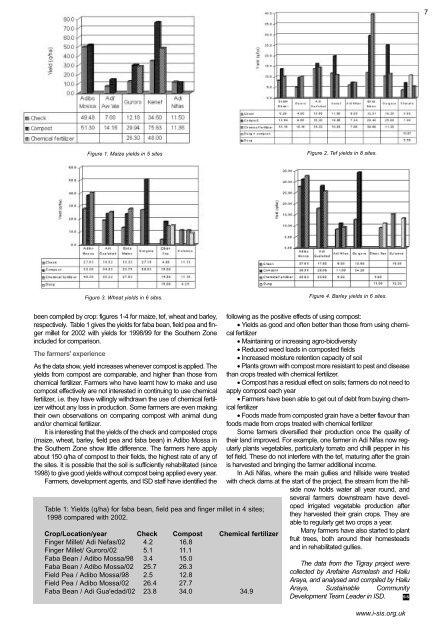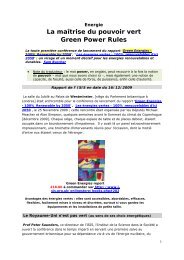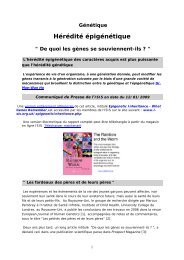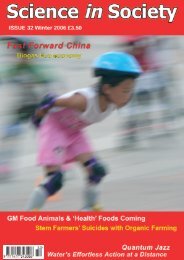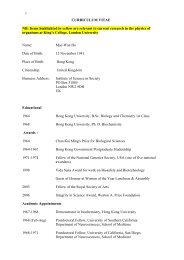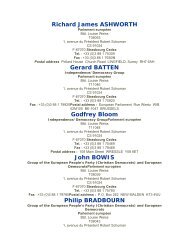Ethiopia goes organic to feed herself - The Institute of Science In ...
Ethiopia goes organic to feed herself - The Institute of Science In ...
Ethiopia goes organic to feed herself - The Institute of Science In ...
You also want an ePaper? Increase the reach of your titles
YUMPU automatically turns print PDFs into web optimized ePapers that Google loves.
7<br />
Figure 1. Maize yields in 5 sites<br />
Figure 2. Tef yields in 8 sites.<br />
Figure 3. Wheat yields in 6 sites.<br />
Figure 4. Barley yields in 6 sites.<br />
been compiled by crop: figures 1-4 for maize, tef, wheat and barley,<br />
respectively. Table 1 gives the yields for faba bean, field pea and finger<br />
millet for 2002 with yields for 1998/99 for the Southern Zone<br />
included for comparison.<br />
<strong>The</strong> farmers' experience<br />
As the data show, yield increases whenever compost is applied. <strong>The</strong><br />
yields from compost are comparable, and higher than those from<br />
chemical fertilizer. Farmers who have learnt how <strong>to</strong> make and use<br />
compost effectively are not interested in continuing <strong>to</strong> use chemical<br />
fertilizer, i.e. they have willingly withdrawn the use <strong>of</strong> chemical fertilizer<br />
without any loss in production. Some farmers are even making<br />
their own observations on comparing compost with animal dung<br />
and/or chemical fertilizer.<br />
It is interesting that the yields <strong>of</strong> the check and composted crops<br />
(maize, wheat, barley, field pea and faba bean) in Adibo Mossa in<br />
the Southern Zone show little difference. <strong>The</strong> farmers here apply<br />
about 150 q/ha <strong>of</strong> compost <strong>to</strong> their fields, the highest rate <strong>of</strong> any <strong>of</strong><br />
the sites. It is possible that the soil is sufficiently rehabilitated (since<br />
1998) <strong>to</strong> give good yields without compost being applied every year.<br />
Farmers, development agents, and ISD staff have identified the<br />
Table 1: Yields (q/ha) for faba bean, field pea and finger millet in 4 sites;<br />
1998 compared with 2002.<br />
Crop/Location/year Check Compost Chemical fertilizer<br />
Finger Millet/ Adi Nefas/02 4.2 16.8<br />
Finger Millet/ Guroro/02 5.1 11.1<br />
Faba Bean / Adibo Mossa/98 3.4 15.0<br />
Faba Bean / Adibo Mossa/02 25.7 26.3<br />
Field Pea / Adibo Mossa/98 2.5 12.8<br />
Field Pea / Adibo Mossa/02 26.4 27.7<br />
Faba Bean / Adi Gua'edad/02 23.8 34.0 34.9<br />
following as the positive effects <strong>of</strong> using compost:<br />
• Yields as good and <strong>of</strong>ten better than those from using chemical<br />
fertilizer<br />
• Maintaining or increasing agro-biodiversity<br />
• Reduced weed loads in composted fields<br />
• <strong>In</strong>creased moisture retention capacity <strong>of</strong> soil<br />
• Plants grown with compost more resistant <strong>to</strong> pest and disease<br />
than crops treated with chemical fertilizer.<br />
• Compost has a residual effect on soils; farmers do not need <strong>to</strong><br />
apply compost each year<br />
• Farmers have been able <strong>to</strong> get out <strong>of</strong> debt from buying chemical<br />
fertilizer<br />
• Foods made from composted grain have a better flavour than<br />
foods made from crops treated with chemical fertilizer<br />
Some farmers diversified their production once the quality <strong>of</strong><br />
their land improved. For example, one farmer in Adi Nifas now regularly<br />
plants vegetables, particularly <strong>to</strong>ma<strong>to</strong> and chilli pepper in his<br />
tef field. <strong>The</strong>se do not interfere with the tef, maturing after the grain<br />
is harvested and bringing the farmer additional income.<br />
<strong>In</strong> Adi Nifas, where the main gullies and hillside were treated<br />
with check dams at the start <strong>of</strong> the project, the stream from the hillside<br />
now holds water all year round, and<br />
several farmers downstream have developed<br />
irrigated vegetable production after<br />
they harvested their grain crops. <strong>The</strong>y are<br />
able <strong>to</strong> regularly get two crops a year.<br />
Many farmers have also started <strong>to</strong> plant<br />
fruit trees, both around their homesteads<br />
and in rehabilitated gullies.<br />
<strong>The</strong> data from the Tigray project were<br />
collected by Arefaine Asmelash and Hailu<br />
Araya, and analysed and compiled by Hailu<br />
Araya, Sustainable Community<br />
Development Team Leader in ISD. SiS<br />
www.i-sis.org.uk


